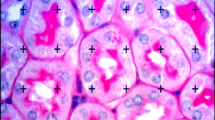Abstract
The nephrotoxic action of aristolochic acid (AA) was investigated in female Wistar rats given single doses of 10, 50 or 100 mg/kg by gastric tube. Renal lesions developed within 3 days, the effect being dose-dependent. Histologically, there was evidence of necrosis of the epithelium of the renal tubules, and functionally, there were rises in plasma creatinine and urea together with increases in urinary glucose, protein, N-acetyl-β-glucosaminidase, gammaglutamyl transferase and malate dehydrogenase. Taking AA as an example, the aim of the present study was to consider the suitability of this model, based on a combination of histology and laboratory investigations, as a short-term test for the detection of nephrotoxic agents.
Similar content being viewed by others
References
Abel G, Schimmer O (1983) Induction of structural chromosome aberration and sister chromatid exchanges in human lymphocytes in vitro by aristolochic acid. Hum Genet 64: 131–133
Bovee KC (1986) Renal function and laboratory evaluation. Toxicol Pathol 14: 26–36
Dierickx PJ (1981) Urinary gamma-glutamyltransferase as an indicator of acute neprotoxicity in rats. Arch Toxicol 47: 209–215
Diézi J, Biollaz J (1979) Renal function tests in experimental toxicity studies. Pharmacol Ther 5: 135–145
Frei H, Würgler FE, Juon H (1983) Aristolochic acid: an old drug is a mutagen. Experientia 39: 685
Frei H et al. (1985) Aristolochic acid is mutagenic and recombinogenic in Drosophila genotoxicity tests. Arch Toxicol 56: 158–166
Hedwall PR (1961) Einfluß der Aristolochiasäure auf die Nierenfunktion der Ratten. Naunyn-Schmiedebergs Arch Pharmacol 24: 550
Jackson L, et al (1964) Aristolochic acid (NSC-50413): Phase I clinical study. Cancer Chemother Rep 42: 35–37
Lison AE (1989) Early detection of renal dysfunction: practical recommendations. Toxicol Lett 46: 251–255
Martincic A (1956) Die toxische Wirkung von Aristolochia clematitis auf die Niere des Pferdes. Zentralbl Allg Pathol 94: 402
Méhes H et al. (1958) Selektive chemische Ausschaltung der Harnkanälchen I. Ordnung bei Kanichen. Naunyn-Schmiedebergs Arch Pharmacol 234: 548–565
Mengs U (1983) On the histopathogenesis of rat forestomach carcinoma caused by aristolochic acid. Arch Toxicol 52: 209–220
Mengs U (1987) Acute toxicity of aristolochic acid in rodents. Arch Toxicol 59: 328–331
Mengs U (1988) Tumor induction in mice following exposure to aristolochic acid. Arch Toxicol 61: 504–505
Mengs U, Klein M (1988) Genotoxic effects of aristolochic acid in mouse micronucleus test. Planta Med 51: 502–503
Mengs U, Stotzem CD (1992) Toxicity of aristolochic acid — a subacute study in male rats. Med Sci Res 20: 223–224
Mengs U, Lang W, Poch JA (1982) The carcinogenic action of aristolochic acid in rats. Arch Toxicol 51: 107–119
Peters G, Hedwall PR (1963) Aristolochic acid intoxication: a new type of impairment of urinary concentration ability. Arch Int Pharmacodyn 145: 334–335
Piscator M (1989) Markers of tubular dysfunction. Toxicol Lett 46: 197–204
Price RG (1982) Urinary enzymes, nephrotoxicity and renal disease. Toxicology 23: 99–134
Roy AK, Neuhaus OW (1967) Androgenic control of a sex-dependent protein in the rat. Nature 214: 618–620
Scharrott M, Frazer AC (1963) The sensitivity of function tests in detecting renal damage in the rat. Toxicol Appl Pharmacol 5: 36–48
Schimmer O et al. (1982) Vergleich der genotoxischen Aktivität von Aristolochiasäure in verschiedenen Testsystemen. Planta Med45: 136
Schmeiser HH, Pool BL, Wiessler M (1985) Mutagenicity and in vitro metabolism of aristolochic acid. Biochem Pharmacol 34: 455–456
Schmeiser HH, Pool BL, Wiessler M (1986) Identification and mutagenicity of metabolites of aristolochic acid formed by rat liver. Carcinogenesis 7: 59–63
Stroo WE, Hook JB (1977) Enzymes of renal origin in urine as indicators of nephrotoxicity. Toxicol Appl Pharmacol 39: 423–434
Thiele KG, Muehrcke RC, Berning H (1967) Nierenerkrankungen durch Medikamente. Dtsch Med Wochenschr 92: 1632–1635
Author information
Authors and Affiliations
Rights and permissions
About this article
Cite this article
Mengs, U., Stotzem, C.D. Renal toxicity of aristolochic acid in rats as an example of nephrotoxicity testing in routine toxicology. Arch Toxicol 67, 307–311 (1993). https://doi.org/10.1007/BF01973700
Received:
Accepted:
Issue Date:
DOI: https://doi.org/10.1007/BF01973700




